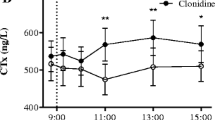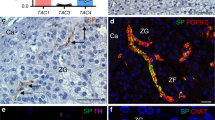Abstract
Recovery of motor function elicited by motor training after cortical lesions in rats is enhanced by norepinephrine (neurotransmitter mediating α1-adrenergic function) and downregulated by α1-adrenergic antagonists. In spite of this, α1-adrenergic antagonists are used to treat elderly patients with hypertension and prostate hyperplasia in stroke settings. The purpose of this study was to determine the effects of a single oral dose of the α1-adrenergic antagonist prazosin on training-dependent plasticity in intact humans, a function thought to contribute to recovery of motor function after cortical lesions. We report that prazosin decreased the ability of motor training to elicit training-dependent plasticity relative to a drug-free condition. These data suggest caution when using α1-adrenergic blockers in rehabilitative clinical settings following brain lesions.


Similar content being viewed by others
References
Akduman B, Crawford ED (2001) Terazosin, doxazosin, and prazosin: current clinical experience. Urology 58:49–54
Butefisch CM, Davis BC, Wise SP, Sawaki L, Kopylev L, Classen J, Cohen LG (2000) Mechanisms of use-dependent plasticity in the human motor cortex. Proc Natl Acad Sci USA 97:3661–3665
Butefisch CM, Davis BC, Sawaki L, Waldvogel D, Classen J, Kopylev L, Cohen LG (2002) Modulation of use-dependent plasticity by d-amphetamine. Ann Neurol 51:59–68
Classen J, Liepert J, Wise SP, Hallett M, Cohen LG (1998) Rapid plasticity of human cortical movement representation induced by practice. J Neurophysiol 79:1117–1123
Ebbs D (2001) A comparison of selected antihypertensives and the use of conventional vs ambulatory blood pressure in the detection and treatment of hypertension. Cardiology 96:3–9
Feeney DM, Westerberg VS (1990) Norepinephrine and brain damage: α noradrenergic pharmacology alters functional recovery after cortical trauma. Can J Psychol 44:233–252
Feeney DM, Weisend MP, Kline AE (1993) Noradrenergic pharmacotherapy, intracerebral infusion and adrenal transplantation promote functional recovery after cortical damage. J Neural Transplant Plast 4:199–213
Goldstein LB (2000) Effects of amphetamines and small related molecules on recovery after stroke in animals and man. Neuropharmacology 39:852–859
Goldstein LB, Dromerick AW, Good DC, Lennihan L, McDowell F, Reding MJ, Plains W, Samsa GP (2002) Possible time window for the detrimental effects of drugs on poststroke recovery. American Academy of Neurology 54th Annual Meeting Program 58:A5–A6
Hovda DA, Sutton RL, Feeney DM (1989) Amphetamine-induced recovery of visual cliff performance after bilateral visual cortex ablation in cats: measurements of depth perception thresholds. Behav Neurosci 103:574–584
Ikegaya Y, Nakanishi K, Saito H, Abe K (1997) Amygdala β-adrenergic influence on hippocampal long-term potentiation in vivo. Neuroreport 8:3143–3146
Inghilleri M, Berardelli A, Cruccu G, Manfredi M (1993) Silent period evoked by transcranial stimulation of the human cortex and cervicomedullary junction. J Physiol (Lond) 466:521–534
Izumi Y, Zorumski CF (1999) Norepinephrine promotes long-term potentiation in the adult rat hippocampus in vitro. Synapse 31:196–202
Karni A, Meyer G, Jezzard P, Adams MM, Turner R, Ungerleider LG (1995) Functional MRI evidence for adult motor cortex plasticity during motor skill learning. Nature 377:155–158
Kobayashi K, Kobayashi T (2001) Genetic evidence for noradrenergic control of long-term memory consolidation. Brain Dev 23 [Suppl 1]:S16–S23
Kujirai T, Caramia MD, Rothwell JC, Day BL, Thompson PD, Ferbert A, Wroe S, Asselman P, Marsden CD (1993) Corticocortical inhibition in human motor cortex. J Physiol (Lond) 471:501–519
Nudo RJ, Plautz EJ, Frost SB (2001) Role of adaptive plasticity in recovery of function after damage to motor cortex. Muscle Nerve 24:1000–1019
Ridding MC, Rothwell JC (1997) Stimulus/response curves as a method of measuring motor cortical excitability in man. Electroencephalogr Clin Neurophysiol 105:340–344
Riva E, Latini R, Cremonesi A, Zaca F, Pagliarani P (1980) Time course of plasma levels and electrophysiologic effects of propranolol in man. J Cardiovasc Pharmacol 2:707–714
Rossini PM, Barker AT, Berardelli A, Caramia MD, Caruso G, Cracco RQ, Dimitrijevic MR, Hallett M, Katayama Y, Lucking CH, Maertens de Noordhout AL, Marsden CD, Murray NMF, Rothwell JC, Swash M, Tomberg C (1994) Non-invasive electrical and magnetic stimulation of the brain, spinal cord and roots: basic principles and procedures for routine clinical application. Report of an IFCN committee. Electroencephalogr Clin Neurophysiol 91:79–92
Sara SJ (1998) Learning by neurones: role of attention, reinforcement and behaviour. C R Acad Sci III 321:193–198
Sawaki L, Boroojerdi B, Kaelin-Lang A, Burstein AH, Butefisch CM, Kopylev L, Davis B, Cohen LG (2002) Cholinergic influences on use-dependent plasticity. J Neurophysiol 87:166–171
Vincent J, Meredith PA, Reid JL, Elliott HL, Rubin PC (1985) Clinical pharmacokinetics of prazosin — 1985. Clin Pharmacokinet 10:144–154
Walker-Batson D, Curtis S, Natarajan R, Ford J, Dronkers N, Salmeron E, Lai J, Unwin DH (2001) A double-blind, placebo-controlled study of the use of amphetamine in the treatment of aphasia. Stroke 32:2093–2098
Werhahn KJ, Fong JK, Meyer BU, Priori A, Rothwell JC, Day BL, Thompson PD (1994) The effect of magnetic coil orientation on the latency of surface EMG and single motor unit responses in the first dorsal interosseous muscle. Electroencephalogr Clin Neurophysiol 93:138–146
Ziemann U, Rothwell JC, Ridding M (1996) Interaction between intracortical inhibition and facilitation in human motor cortex. J Physiol (Lond) 496:873–881
Acknowledgements
We wish to thank our subjects for their participation in the study, and M. Hallett for critical comments. We also gratefully acknowledge A.H. Burstein, R.Villadiego and N. Dang for invaluable technical support and D.G. Schoenberg for skillful editing. This work was partially supported by a grant from the Office of Alternative Medicine, National Institutes of Health, USA (OAM-NIH).
Author information
Authors and Affiliations
Corresponding author
Rights and permissions
About this article
Cite this article
Sawaki, L., Werhahn, K.J., Barco, R. et al. Effect of an α1-adrenergic blocker on plasticity elicited by motor training. Exp Brain Res 148, 504–508 (2003). https://doi.org/10.1007/s00221-002-1328-x
Received:
Accepted:
Published:
Issue Date:
DOI: https://doi.org/10.1007/s00221-002-1328-x




